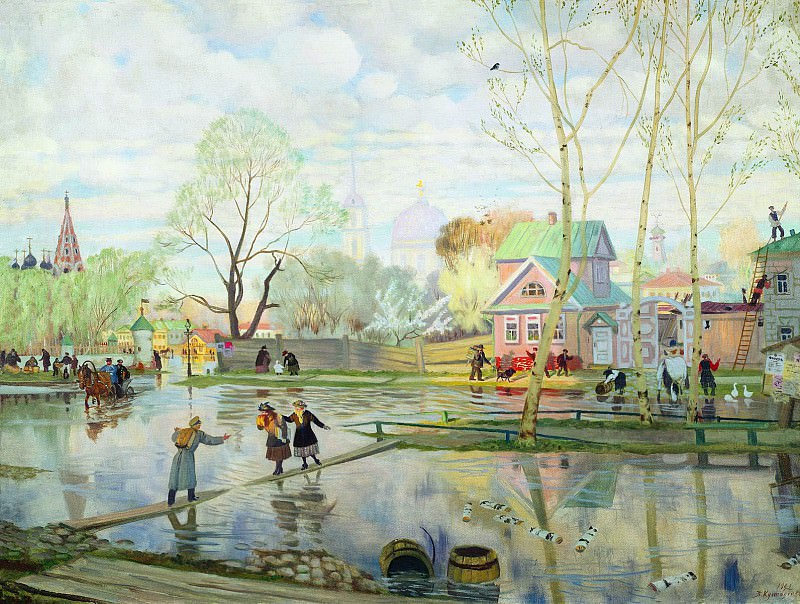Spring Boris Kustodiev (1878-1927)
Boris Kustodiev – Spring
Edit attribution
Download full size: 1592×1200 px (0,4 Mb)
Painter: Boris Kustodiev
In 1921, the Russian artist Kustodiev was already bedridden due to a severe illness. But the painting he painted during this period, Springtime, looks like a veritable hymn of joie de vivre. Bright, pastel, as if sweet and powdered with sugar houses, sky and earth, people and animals - everything in the picture is the embodiment of a certain sweet childhood dream. The artist painted "Spring" as a symbol of the new birth, awakening and resurrection of nature and all life.
Description of Boris Kustodiev’s painting "Spring".
In 1921, the Russian artist Kustodiev was already bedridden due to a severe illness. But the painting he painted during this period, Springtime, looks like a veritable hymn of joie de vivre. Bright, pastel, as if sweet and powdered with sugar houses, sky and earth, people and animals - everything in the picture is the embodiment of a certain sweet childhood dream.
The artist painted "Spring" as a symbol of the new birth, awakening and resurrection of nature and all life. The plot of the painting is full of events. Cotton-colored clouds float across the gentle blue sky, reflected in a moving stream of melted water. A man on a wooden crossbar offers help to two bewildered ladies in the middle of a flooded stretch of street.
On the right side of the picture, peasant daily life is in full swing: a woman is rolling a barrel, a guy is herding geese, pecking chickens can be seen in the open gate of the yard, two other men are working on the roof, children are playing, an old man with a dog is going about his business.
To the left, commerce is in full swing, and a coachman is carrying a passenger across the shallow river he created. In the background of all this activity, the domes of churches are visible in a hazy haze. The plant kingdom in the entire picture is diluted with animal life. Even on the branch of a tall birch tree Kustodiev did not forget to nestle a solitary bird.
In "Springtime" everything moves, blooms and sings. When you look at it you can feel the fresh, frosty spring breeze and hear the murmur of people and voices of animals. And all this is so harmonious, coherent, as if described here one big Russian soul.
"Spring" gives the viewer a feeling of joyful awakening. The artist worked on the canvas from memory, and looking at the result of his painstaking work, you realize how impressed he once was with the first spring floods, nature and the Slavic people, that with such love and accuracy the reality is conveyed.
Кому понравилось
Пожалуйста, подождите
На эту операцию может потребоваться несколько секунд.
Информация появится в новом окне,
если открытие новых окон не запрещено в настройках вашего браузера.
You need to login
Для работы с коллекциями – пожалуйста, войдите в аккаунт (open in new window).


















You cannot comment Why?
Peeking through bare trees and newly budding foliage, we see traditional Russian houses with colorful roofs and ornate architectural details, indicative of rural Russian life. Churches with distinctive onion domes dominate the skyline in the distance, grounding the scene in a specific cultural context. The overall impression is lively and somewhat chaotic, with various activities happening simultaneously.
Subtexts of the painting include the celebration of springs arrival, marked by the melting snow and subsequent flooding. This is a time of transition and renewal, where nature reasserts its power. The painting also seems to capture the resilience and adaptability of the villagers, who continue their daily lives despite the unusual circumstances. The juxtaposition of the natural phenomenon of flooding with the human activities suggests a harmonious, albeit sometimes challenging, coexistence between humans and nature. The scene evokes a sense of community, as people help each other navigate the flooded streets. The vivid colors and light suggest a cheerful and hopeful atmosphere, characteristic of the awakening of spring. The presence of children playing and working adults alike emphasizes the continuous flow of life despite natural disruptions.